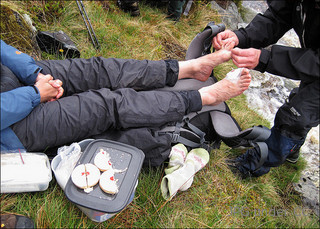Bunion Relief: Surgical and NonSurgical treatments
You will most likely be needing bunion relief without surgery if a small area at the base of your big toe has become abnormally large. This increase in size is called a bunion, and it is caused by the formation of extra bone in the area in addition to having a misaligned big toe.
The area may become tender and red, and you may not be able to walk without experiencing pain. In some types of bunions, the swelling may occur at the base of the smallest toes instead.
Causes of Bunions – The Facts
Ill-fitting footwear is the most common cause of bunions, though evidence has been discovered that some people may be more genetically predisposed to this condition. Women’s shoes have been regarded by many as the culprit of bunions, especially the tight-fitting ones that have high heels and are narrow at the toes.
These kinds of shoes, as well as genetics, may explain why more women contract this condition than men; statistically, 10 women get bunions for every man with this condition. To avoid foot bunions, more women are choosing to buy more comfortable shoes. For those who already have this condition, bunion relief shoes are an option.
Nonsurgical Treatment – Overview
Not all bunions present symptoms, though the most common one is chronic bunion pain that appears when walking, but disappears when the patient rests. To confirm this condition, a doctor may have some X-rays taken to evaluate the condition of the foot and treatment options.
The degree of severity of the foot bunion may be determined, and the X-ray may also check for underlying conditions such as gout or arthritis, which are common in older people.
For very mild cases, the treatment may simply require the patient to avoid too much walking and the use of constrictive and ill-fitting shoes. By wearing loose and wider walking shoes instead, the pain caused by the bunion may go away.
Anti-inflammation medicines may also be prescribed to provide pain relief. These medications, which may include ibuprofen and aspirin, may help lessen the swelling, as well as bunion pain. A local cold pack may also be applied to the affected area.
Additionally, there are many bunion pain relief products that offer non-surgical bunion treatment options, including toe separators for bunions and special shoes named bunion splints.
A Look at Surgical Treatments for Bunions
If the condition has become more serious, then a remedy may come in the form of surgery. This surgical procedure is called a bunionectomy, and the bunion is dealt with by the removal of the bony growth while the big toe is realigned to its proper position.
Though some operations may require patients to undergo general anesthesia, in recent years less invasive bunion surgeries are now being performed more frequently.
For the most part, bunionectomies are generally successful, though, in some cases, a second operation may be necessary to provide pain relief. Recovery takes about two months or so, and a patient may be largely immobile and need the use of crutches to move around. Orthopedic casts are seldom used these days; instead, the bone may be stabilized with screws, pins, and other hardware materials.
If the condition has become quite unbearable, then the only option is bunion surgery. Obviously, surgery can be quite expensive, but some health insurance covers surgery for bunion relief, so check out your options with your healthcare company.


Leave a Reply